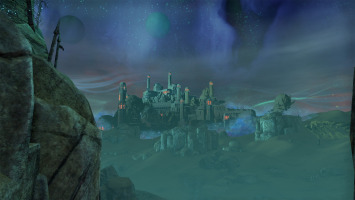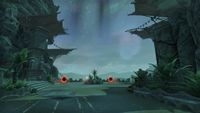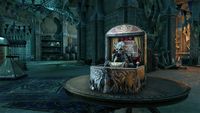Lore:Bearers of Fargrave
| This page or section is incomplete. You can help by adding to it. Needs to be updated with new info from Gold Road For more information, see the help files, the style guide, and this article's talk page. |
| Bearers of Fargrave | |||
|---|---|---|---|
 Corpse of one of the Bearers Corpse of one of the Bearers
|
|||
| Type | Unknown, possibly Daedra | ||
| Range | Fargrave (extinct) | ||
The Bearers of Fargrave (nicknamed Gargantuans)[1] are mysterious extinct beings commonly believed to be a kind of Daedra[2][3] or, according to less popular theories another kind of being that are neither Daedric, Aedric, or mortal in origins.[2] Their skeletons can be found in Fargrave,[3][2] and are considered one of the city's best features.[4]
History and Beliefs[edit]
Little is known of the history of the Bearers and the opinions regarding their origins are divided.[2] According to some legends the Bearers were once porters for a great palanquin that traveled the void of Oblivion but they eventually died. Unlike other Daedra however, they did not reform.[3]
According to popular theory among the mortal inhabitants of Fargrave, the realm was once the domain of four rival Daedric Princes that competed for complete sovereignty of the land. As a result of their constant and unending battles, they eventually destroyed each other simultaneously and their bodies collapsed and eventually decomposed, leaving behind the four giant skeletons.[2]
Another belief regarding the Bearers is that the Fargrave was once a necropolis for a race of gargantuans that were neither Daedra, Aedra, or mortal'. When their time to depart was approaching they would wander into Fargrave, sit or lie down, and eventually expire.[2] Another belief regarding the Bearers is that before Fargrave settled into its current location in Oblivion it was carried from place to place by the four Bearers. That is why it is also known as "the Celestial Palanquin". Once in ancient times, four great colossi moved the city onto their shoulders from one location to another for eternity. This process resulted in establishing connections between the realms the city visited. Those connections took the form of permanent portals which remained active as of 2E 582.[4][2]
It is believed that once those portal connections solidified, the need to physically move Fargrave became unnecessary. Once they lost their purpose they also lost the will to exist. Because they could not imagine departing the place they supported for so long, they all sat down and died.[2]
According to some beliefs, the Bearers were enslaved and bound to carry Fargrave for masters who were lost to history. Other groups believe that they were faithful servants and protectors of ancient inhabitants of Fargrave.[2]
Legacy[edit]
The nature of the realm of Fargrave as a crossroads where the paths through Oblivion become easier to navigate is believed to be derived from the travels of the Bearers.[2]
The central district of the city of the plane of Fargrave is surrounded by inanimate gargantuan skeletons that form a sort of protective boundary around it. Various lesser skeletal parts form natural features throughout the city.[2] Certain locations in the city of Fargrave, such as The Bearer's Rest inn are named in honor of the Bearers[5][6] or after specific parts of their remnants.[7]
The imagery of the Bearers of Fargrave was used in the artistic renditions of the Celestial Palanquin circa 2E 582.[8] Carved pipes, fashioned in the shape of the Bearers were commonly found in Fargrave.[9] Massive, fossilized teeth, believed to originate from one of the Bearer's skulls were rarely found and sold in Fargrave.[1]
References[edit]
- ^ a b Gargantuan's Tooth item description in ESO: The Deadlands
- ^ a b c d e f g h i j k The Bearers of Fargrave — Orette Arbogasque, Mortal Historian
- ^ a b c Vistha-Li's dialogue in ESO: The Deadlands
- ^ a b Madam Whim's dialogue in ESO: The Deadlands
- ^ The Bearer's Rest in ESO: The Deadlands
- ^ Lyranth's dialogue during The Celestial Palanquin in ESO: The Deadlands
- ^ The Wishbone in ESO: The Deadlands
- ^ Music Box, Fargrave Daydreams item description in ESO
- ^ Sculpted Bearer Pipe item description in ESO: The Deadlands



